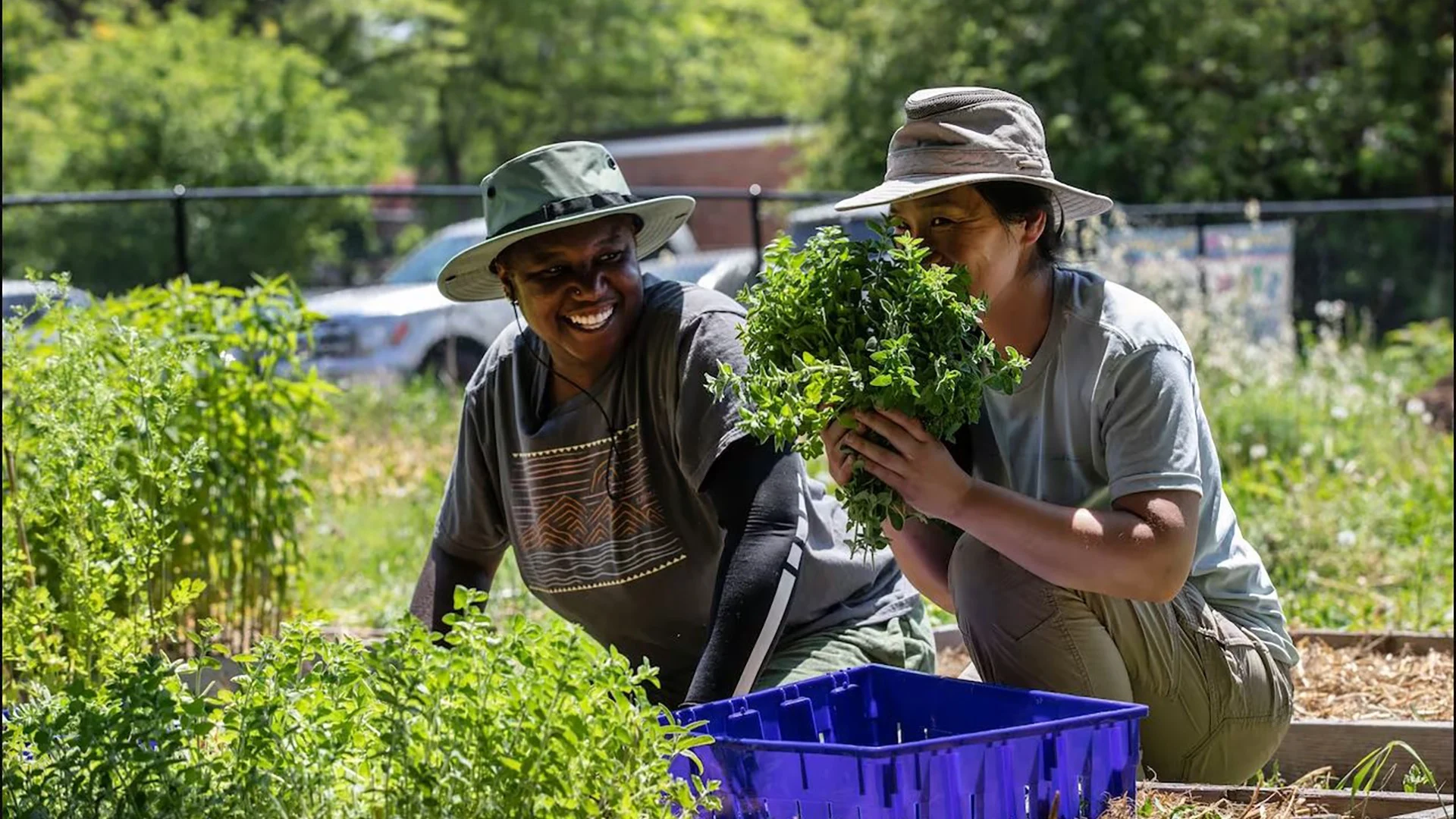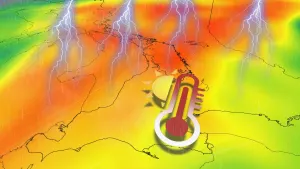
Yes, you can run a farm inside a big city
A sprawling rooftop greenhouse on a former Sears department store warehouse in Montreal, full of cucumber and bean plants, doesn't appear to have much in common with rows of radish and red lettuce leaves poking out of the dirt and hay in a Toronto backyard.
But Lufa Farms and Zawadi Farm are more similar than you might think. Both were started by Canadian immigrants who previously worked in the tech industry. Both bypass the supermarket and sell the food they grow directly to customers. And both are growing food in Canada's biggest cities.
They're not alone. More farmers and gardeners are making space in cities to grow crops — alongside Edmonton's ring road, in a hydro corridor in Toronto, in other people's front yards in Vancouver, inside a school in Moncton, N.B., on a former tennis court in Calgary, in carports on a street in Montreal and in the city-owned right of way alongside a sidewalk in Ottawa, to name a few.
Urban farming advocates say growing food where people live can make fresh vegetables more accessible and affordable amid rising food prices and supply issues linked to global problems like droughts, volatile energy prices and the pandemic. They say locally grown food can also have a lower climate impact, while providing jobs and environmental benefits for local communities.
READ MORE: How just 1% of farmland could meet one third of Canada’s energy needs
Lufa Farms has built four rooftop greenhouses on industrial buildings in Montreal, covering more than 300,000 square feet and making use of the heat generated from the buildings below.
"We're taking up no new land," said co-founder Mohamed Hage.
Zawadi Farm is in Jessey Njau's own backyard, as well as his next-door neighbour's and a plot at Toronto's Downsview Park. In his backyard greenhouse, he starts in the spring with arugula, bok choy, kale, chard, beets, lettuce and cilantro, which are later swapped for warm-weather crops such as basil, tomatoes and cucumbers.
He grows microgreens like sunflower and chickpea sprouts in his basement. And he sees many other potential growing sites around him.
Next door to a school in another part of town, the grounds of the Church of Our Saviour, Don Mills have been transformed into The Common Table Farm run by the Flemingdon Park Ministry.
The non-profit community group grows produce like radishes, bitter melons and eggplants, and has also planted a few gooseberry, saskatoon berry and currant bushes.
"The produce here is for community-facing food insecurity, please do not harvest," reads a sign on the gate.

Anélia Victor holds a bunch of freshly harvested radishes. They say the farm grows a huge range of crops, from garlic to eggplant to bitter melon, and is able to feed about 100 families. (Nav Rahi/CBC)
Anélia Victor, urban farmer and educator for the group, says many small patches of green space around the city could be transformed into gardens or farms.
"If we are able to nurture the land and nurture the soil," they said, "we can be able to feed a lot of people."
Tackling food insecurity
Sarah Elton, director of the Food Health Ecosystems Lab at Toronto Metropolitan University, has noticed more urban farms, including many that are not-for-profit, growing food to feed people in the local community.
A recent report from RBC found that food prices have increased 18 per cent in past two years. She says this, combined with high housing costs and precarious jobs, have more people turning to farming and gardening as a way to make food more affordable.
"We can grow it and we can choose a way to distribute it within our communities for free or for a lower cost," Elton said.

Volunteers Andrew Harding and Mary Anne Negate prepare a bed for new plants at The Common Table Farm, which uses land owned by the Church of Our Saviour, Don Mills in Toronto. Advocates say there's lots of land that could be farmed around buildings such as churches and schools. (Nav Rahi/CBC)
Victor estimates that the produce from The Common Table feeds over 100 families in the Flemingdon Park neighbourhood, and it also gets delivered to a seniors' residence.
They said recipients are so excited and grateful that it's difficult to keep up with the demand.
But despite its popularity, the farm may close at the end of the season. Maria Reolin, executive director of the Flemingdon Park Ministry, said the group's donation-based programming has been struggling since the pandemic.
Why do urban farms share their food?
Hage says Lufa did well during the pandemic, seeing a huge increase in subscribers as people shied away from the supermarket.
"So by the end of the year, we really wanted to come up with a way to give back to the community," Hage said. The company connected with local non-profits to find families in need, and asked subscribers to donate food credits that low-income families can use to buy food at discounted prices.
Currently, Hage says, the program supports 160 families.

Jessey Njau stands in the greenhouse in his Toronto backyard, part of Zawadi Farm. The food is sold directly to customers, bypassing the supermarket. (Craig Chivers/CBC)
Similarly, Njau asks customers to donate boxes to needy families when they're out of town. Zawadi Farm also partners with local charities to connect its food with those in need.
Colleen Stevens is an outreach worker with one of those charities, Neighbour Link North York. She said the food is very much appreciated at a time when food banks have less to offer.
"They certainly aren't offering fresh vegetables," she said.
Watch below: Urban farm gets boost from excessive rain
Dealing with climate change
Many cities, including Mississauga, Ont., and Montreal have made urban farming part of their strategy to fight and adapt to climate change. Food systems generate about a third of the world's greenhouse gas emissions, and the City of Mississauga notes that there are ways to reduce those emissions and for the food system to become more sustainable and resilient.
The Toronto Region Conservation Authority, which leases 279 hectares of land to farmers, says growing food locally reduces carbon emissions from food transport.
It adds that farms improve stormwater management by acting as a sink for excess water, reducing the risk of flooding — one risk that is growing with climate change.
Farming also has the potential to mitigate climate change by storing carbon.
However, Canada has been losing its farmland, largely to urbanization, especially in eastern Canadian provinces such as Ontario, P.E.I., and Newfoundland.
One of the food system's major sources of emissions is food loss and waste, as rotting food generates greenhouse gases. About 25 to 30 per cent of food produced is lost or wasted, representing eight to 10 per cent human-caused GHG emissions between 2010 and 2016, according to the Intergovernmental Panel on Climate Change.
Both Njau and Hage say their close connection to those who consume their produce minimizes waste.
Hage says Lufa waits until the produce is sold before picking it, so it can pick the right amount.
Njau has a similar approach.
"We don't grow without knowing where the food is going," he said.
Anything that isn't edible gets composted.
Protection against problems from elsewhere
According to RBC, the price of raw food commodities has been affected by high wheat, fertilizer and natural gas prices linked to Russia's invasion of Ukraine, along with the severe drought in the Prairies.
Victor said with climate change, it's getting more expensive to access many vegetables grown elsewhere — just as it becomes easier to locally grow more tropical crops such as bitter melons.
Hage noted that as shelves in many grocery stores emptied in the early months of the pandemic — and as prices spiked for some products — he became convinced that producing food locally is essential.
"We realized how important it is to be self-sufficient," he said.
Other benefits for customers and the community
Njau acknowledges that his produce isn't necessarily cheaper than what you'd buy from the grocery store, but says once customers taste it, they recognize the value.
"'Like wait a minute, it doesn't taste like water. I taste flavour in this thing.' That's the kind of knowledge we want people to understand," he said.
Both Hage and Njau said there's also value in knowing where your food comes from, how it was grown and that buying it creates local jobs.

Anélia Victor and Melodie Ng stand among some berry bushes planted in the yard of the Church of Our Saviour, Don Mills — some of the few fruits among the vegetables grown at The Common Table Farm. (Nav Rahi/CBC)
Elton said urban farms and gardens show us that the city is not separate from nature.
"In the garden, we're reminded of this intimate connection we have with plants," she said.
This story, written by Emily Chung, was originally published by CBC.
Thumbnail image: Anélia Victor and Melodie Ng harvest oregano at The Common Table Farm to deliver it to a seniors' home. The farm grows food in a churchyard for people in Toronto's Flemingdon Park, a low-income neighbourhood. (Nav Rahi/CBC)










